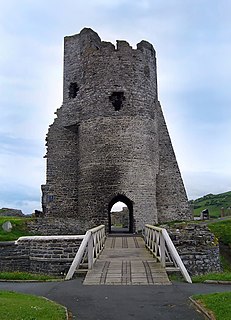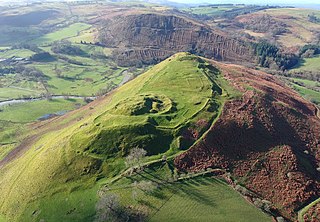History
The outcrop on which the castle stands was first fortified in the late 12th century by Meredydd Gethin. Morgan ap Hywel, who succeeded his father Hywel as Lord of Gwynllwg around 1215, lost Caerleon in October 1217 to the forces of William Marshal, 1st Earl of Pembroke (1146–1219), lord of Striguil. However, Morgan managed to retain Castell Machen for most of his life. Morgan strengthened it by the addition of a tower. He probably built the round tower, or keep, in 1217. Gilbert Marshal captured Castell Meredydd in 1236 during a truce between Llywelyn the Great and King Henry III of England. After Marshal took the castle he seems to have fortified it with a bailey and curtain wall. He was forced to return it to Morgan by the terms of the truce, or "for fear of the lord Llywelyn".
Morgan died not long before 15 March 1248. He was succeeded by his grandson Meredudd ap Gruffudd (died 1270), son of his daughter Gwerful and of Gryffudd ap Maredud, a grandson of Lord Rhys. Meredudd inherited the castle. Gilbert de Clare, 7th Earl of Gloucester and lord of Glamorgan, took the castle in 1266 when he overran Senghenydd. The castle is listed as property of the last earl in 1314, and then is no longer mentioned in the records.

Criccieth Castle is a native Welsh castle situated on the headland between two beaches in Criccieth, Gwynedd, in North Wales, on a rocky peninsula overlooking Tremadog Bay. It was built by Llywelyn the Great of the kingdom of Gwynedd, but was heavily modified following its capture by English forces of Edward I in the late 13th century.

Clun Castle is a medieval ruined castle in Clun, Shropshire, England. Clun Castle was established by the Norman lord Robert de Say after the Norman invasion of England and went on to become an important Marcher lord castle in the 12th century, with an extensive castle-guard system. Owned for many years by the Fitzalan family, Clun played a key part in protecting the region from Welsh attack until it was gradually abandoned as a property in favour of the more luxurious Arundel Castle. The Fitzalans converted Clun Castle into a hunting lodge in the 14th century, complete with pleasure gardens, but by the 16th century the castle was largely ruined. Slighted in 1646 after the English Civil War, Clun remained in poor condition until renovation work in the 1890s.

Aberystwyth Castle is a Grade I listed Edwardian fortress located in Aberystwyth, Ceredigion, Mid Wales. It was built in response to the First Welsh War in the late 13th century, replacing an earlier fortress located a mile to the south. During a national uprising by Owain Glyndŵr, the Welsh captured the castle in 1404, but it was recaptured by the English four years later. In 1637 it became a Royal mint by Charles I, and produced silver shillings. The castle was slighted by Oliver Cromwell in 1649.

Swansea Castle is located in the city centre of Swansea, Wales, UK. It was founded by Henry de Beaumont in 1107 as the caput of the lordship of Gower. The castle is now ruined and only two blocks remain, though the site has been improved in the 2010s for use as a public space.
The Castle of Dinerth is a Welsh castle located near Aberarth, Ceredigion, west Wales that was completed c. AD 1110. It is also known as Hero Castle, presumably from the Norse hiro.

Dolbadarn Castle is a fortification built by the Welsh prince Llywelyn the Great during the early 13th century, at the base of the Llanberis Pass, in northern Wales. The castle was important both militarily and as a symbol of Llywelyn's power and authority. The castle features a large stone keep, which historian Richard Avent considers "the finest surviving example of a Welsh round tower". In 1284 Dolbadarn was taken by Edward I, who removed some of its timbers to build his new castle at Caernarfon. The castle was used as a manor house for some years, before falling into ruin. In the 18th and 19th century it was a popular destination for painters interested in Sublime and Picturesque landscapes. It is now owned by Cadw and managed as a tourist attraction, and is protected as a grade I listed building.

Cefnllys Castle was a medieval spur castle in Radnorshire, Wales. Two successive masonry castles were built on a ridge above the River Ithon known as Castle Bank in the thirteenth century, replacing a wooden motte-and-bailey castle constructed by the Normans nearby. Controlling several communication routes into the highlands of Mid Wales, the castles were strategically important within the Welsh Marches during the High Middle Ages. As the seat of the fiercely contested lordship and cantref of Maelienydd, Cefnllys became a source of friction between Llywelyn ap Gruffudd and Roger Mortimer in the prelude to Edward I's conquest of Wales (1277–1283). Cefnllys was also the site of a borough and medieval town.

Madog ap Llywelyn was the leader of the Welsh revolt of 1294–95 against English rule and proclaimed "Prince of Wales". The revolt was surpassed in longevity only by the revolt of Owain Glyndŵr in the 15th century. Madog belonged to a junior branch of the House of Aberffraw and was a distant relation of Llywelyn ap Gruffudd, the last recognised native Prince of Wales.

Castell y Bere is a Welsh castle near Llanfihangel-y-pennant in Gwynedd, Wales. Constructed by Llywelyn the Great in the 1220s, the stone castle was intended to maintain his authority over the local people and to defend the south-west part of the princedom of Gwynedd. In 1282, war with Edward I of England resulted in the death of Llywelyn's grandson, Llywelyn ap Gruffudd, and Castell y Bere fell to English forces. Edward I expanded the castle further and established a small town beside it. In 1294 the Welsh leader Madog ap Llywelyn mounted a major revolt and the castle was besieged and apparently burnt. Edward did not repair it and it became ruined. Today it is in the hands of Cadw and operated as a tourist attraction.

Wiston Castle is a motte and bailey castle in the Pembrokeshire village of Wiston in south west Wales and is one of the best examples of its type in Wales. The castle and village were founded by Wizo, a Flemish settler who was granted the land by Henry I of England after he had wrested control from the previous owner, Arnulf de Montgomery. The castle was captured by the Welsh on several occasions but on each occasion it was retaken. It was abandoned during the thirteenth century when the then owner moved to nearby Picton Castle.

Gwent was a medieval Welsh kingdom, lying between the Rivers Wye and Usk. It existed from the end of Roman rule in Britain in about the 5th century until the Norman invasion of Wales in the 11th century. Along with its neighbour Glywyssing, it seems to have had a great deal of cultural continuity with the earlier Silures, keeping their own courts and diocese separate from the rest of Wales until their conquest by Gruffydd ap Llywelyn. Although it recovered its independence after his death in 1063, Gwent was the first of the Welsh kingdoms to be overrun following the Norman conquest.
This article is about the particular significance of the century 1201–1300 to Wales and its people.

Blaenllynfi Castle is a privately owned ruinous stone castle near the village of Bwlch in southern Powys, Wales. It was probably built in the early thirteenth century. It was captured several times during the rest of the century and apparently was never fully repaired afterwards and fell into ruins. It is a Scheduled Ancient Monument.

Senghenydd is a former mining town in the community of Aber Valley in South Wales, approximately four miles northwest of the town of Caerphilly. Historically within the county of Glamorgan, it is now situated in the county borough of Caerphilly. In the United Kingdom Census 2001, the population of the Aber Valley was 6,696.

Neath Castle is a Norman castle located in the town centre of Neath, Wales. Its construction was begun by Robert, Earl of Gloucester, the nominal Lord of Glamorgan, at a date estimated between 1114 and 1130. It is also referred to as "Granville's Castle", after Richard I de Grenville, Lord of Neath, who has also been credited with its construction. The town of Neath takes its Welsh name, "Castell-nedd", from the castle.
Castell Du, also known as Sennybridge Castle or Castell Rhyd-y-Briw, is located approximately eight miles west of Brecon in Powys, Wales, and is believed to be the work of Llywelyn ap Gruffudd, Prince of Wales. Its history is largely obscure, but a reference to a castle at Rhyd-y-Briw in a document of 1271 is believed to refer to the fortification, and it is not unreasonable to assume that work commenced on it during Llywelyn's triumphal years in the 1260s. Its life would seem to have been short, as there is no further reference to it in thirteenth-century documents, and it seems likely that it was captured by the forces of Edward I of England during the war of 1276–77 and subsequently abandoned. Much of the site remains to be excavated; the remains of a D-shaped tower are visible, and two other towers may lie under pill-boxes erected during the Second World War.

Dyserth Castle is a castle site in Denbighshire in the country of Wales. It is a scheduled monument protected ancient borough on a ridge north of the village of Dyserth. It was the last castle of the British fortified defences on the Clwydian hill range in the Middle Ages. The nearby village of Dyserth got its name from the castle.
Morgan ap Hywel was Lord of Gwynllwg in Wales from about 1215 until his death in 1245, and for many years laid claim to the lordship of Caerleon, which had been seized by the Earl of Pembroke. For most of his life he was at peace with the English, at a time when there were periodic revolts by Welsh leaders against their rule. He may have participated in a crusade between 1227 and 1231.
Owain ap Caradog, known as Owain ‘Wan’ was the son and heir of King Caradog ap Gruffydd of Morgannwg, who contested the Kingdom of Deheubarth and was killed in the Battle of Mynydd Carn in 1081. Owain contented himself by ruling the former sub-kingdom and later Lordship of Gwynllwg, while the title of King of Morgannwg went to his relative Iestyn ap Gwrgant, who was subsequently deposed c. 1090 as part of the Norman conquest of Wales. In spite of this Owain continued to hold onto territories between the Rhymney and Usk, and may, probably with some struggle, have held onto some or all of Caerleon, where in 1086 the Domesday book records that a small colony of eight carucates of land was held by Turstin FitzRolf, standard bearer to William the Conqueror at Hastings, under the overlordship of William d'Ecouis, a magnate with lands in Herefordshire, Norfolk and other counties. Also listed on the manor were three Welshmen with as many ploughs and carucates, who continued their Welsh customs.
Iorwerth ab Owain was a Welsh prince of Gwynllŵg and Lord of Caerleon.














